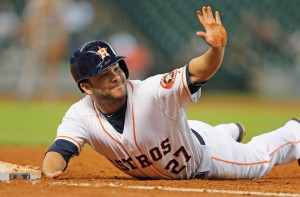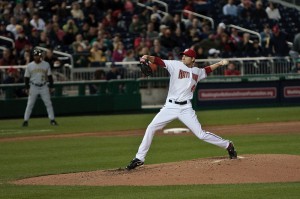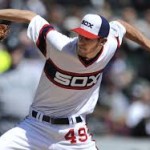
Altuve was a huge driving factor for me in Fantasy this year … but it wasn’t enough to win the championship. Photo via mlblogs.com
Usual caveats apply; if you don’t care about Fantasy Baseball, you probably won’t care about this post. I’ll return to Nats next week and am hoping to return to my detailed per-level pitching reviews this year….
Fantasy Baseball has wrapped up for the year; most leagues are doing their playoff finals this week. This is my post-mortem for the year. Here was my 2016 team preview article at the beginning of the year to show my drafted team.
My strategy for this year (pulled from the preview article):
- focus on hitting; don’t load up on OF early.
- wait on pitching. With the conversion to QS, I felt like there was a ton of value later on with starters instead of burning early spots.
- I wanted four closers (and got them … though the last one is really iffy).
- I only wanted the minimum hitters, figuring I could start churning and burning based on the lower-end starters that weren’t working out.
- I wanted a good mix of solid dependable players with a couple of high-end rookies (advice I liked after hearing it on a podcast)
- Lastly I didn’t want to spend early on either C or 1B; catcher since there’s just so much turnover, 1B since there’s so much value later in the draft.
Results: My strategy worked out pretty well. I had very good hitters, I got quality starters late and off waivers, I kept 3-4 closers all year, and I finished the regular season in 1st place by 3 games. I was able (as always) to find quality OF and 1B on the waiver wire (in my case, Will Myers who exploded). My one strategy miss may have been waiting on a Catcher; my catcher was awful all year and there was no help on the waiver wire until later (see below for who I picked up).
Even despite finishing in 1st place regular season, my pitchers badly declined later in the year, I had an off-week offensively in the playoffs and I got bounced by the 5th place team in the semis. And when I say bounced, I mean I lost 2-8 on the week. So, a disappointing finish. But i think the strategy was sound and I’ll do it again next year.
Here’s how I ended up in team stats for the season:
- Runs; 3rd
- HRs: 1st
- RBIs: 4th
- SBs: 9th
- OBP: 2nd
- Saves: 1st
- Ks: 3rd
- ERA: 5th
- Whip: 3rd
- QS: 3rd
Yeah; too bad we’re not playing Rotisserie. The only category i was guaranteed to lose nearly every week was Steals. Overall I had a pretty good year.
Here’s my initial draft and the player disposition on the year.
I drafted 9th out of 10 spots. Here is my team (the two numbers are Round and # overall).
- 9 Nolan Arenado, Col 3B: Kept all year and finished #6 in Yahoo.
- 12 Jose Altuve, Hou 2B: Kept all year and finished #11 in Yahoo; he was much higher but has really struggled this last month, hurting his September value.
- 29 George Springer, Hou OF; Kept all year and finished #29 in Yahoo, almost exactly in line with his ADP and his rank. Also struggled badly in september.
- 32 J.D. Martinez, Det OF: Missed 6 weeks mid-season so I dropped him, but picked him back up and he was not awesome but certainly not contributing as a 4th round pick.
- 49 Miguel Sano, Min DH; was decent early, then fell off a cliff and eventually missed time. He ended up on the Waiver wire.
- 52 Carlos Carrasco, Cle SP: kept him all year even though he hit the D/L at some point and was awful in September. I lost K’s by 9 in the playoffs … and got nothing from him thanks to the ill-timed line drive through the box.
- 69 Corey Seager, LAD SS: Kept all year; finished #67 in Yahoo. A very shrewd pickup here.
- 72 Jeurys Familia, NYM RP: Kept all year, finished #71 in Yahoo. Very solid Closer.
- 89 Cody Allen, Cle RP: I dropped him when the Indians acquired Andrew Miller … then missed out when Allen turned out to be mostly the closer again. So
- 92 Danny Salazar, Cle SP: Another cleveland SP who spent time on the D/L but who was good when active; I dropped him during the playoffs when he strained his forearm.
- 109 David Peralta, Ari OF: My first real draft miss; he was ok for the first 6 weeks, then hit the D/L for a bit, then kept getting injured and didn’t play after early August.
- 112 Carlos Martinez, StL SP: My biggest “impatient drop” of the year; he struggled all the way through May and I dumped him; he got picked up by (ironically) the guy who beat me in the playoffs and he was stellar the rest of the way.
- 129 Adam Eaton, CWS OF: I dumped him at some point and he was basically on waivers the whole year; never good enough to pick up versus whoever had the hot hand.
- 132 Salvador Perez, KC C: Ugh; depth at Fantasy C is so thin, I stuck with him for almost the entire year. Luckily I got to Gary Sanchez before anyone else, and rode him through the playoffs.
- 149 Jeff Samardzija, SF SP: Had him for a bit, thinking he’d be good in SF. He was so streaky up and down that I dumped him. He eventually got picked up by a competitor but was never really *that* good.
- 152 Justin Verlander, Det SP: My other big “impatient drop.” I had Verlander two years ago and thought i’d get a find; he had a 6.49 ERA through his first 6 games. I dumped him … and he finished the year Yahoo ranked #20. Ugh.
- 169 Fernando Rodney, SD RP: A huge closer steal for yours truly; he was lights out right up until he got traded to be a setup guy. That was a bummer.
- 172 Lucas Duda, NYM 1B: My perennail late-round 1B pickup, only this year he got hurt and was never really a fantasy player.
- 189 Lance McCullers, Hou SP: this late-round flier was on my D/L for weeks until it became apparent he wasn’t going to shwo up any time soon; he made just 2 starts all year.
- 192 Yordano Ventura, KC SP: awful all year; yahoo ranked #732.
- 209 J.J. Hoover, Cin RP: a flier on a closer-by-committee was the first player I dropped. Luckily I caught on with some lower-end closers and did very well. I got Luke Gregerson in Houston, who did well for a time.
So, just 8 of 21 players on my team all year from the draft. And not one player drafted after the 10th round made it all the way though. I’m not sure if that’s an indictment of my drafting, or just the nature of fantasy baseball.
Here was my team (save for playoff transactions) at the end of the year:
- C: Gary Sanchez: What a monster; #11 for the month of September.
- 1B: Wil Myers: another waiver-wire monster: He ended up yahoo ranked #30 on the year and I had him for most of it.
- 2B, SS, 3B: Altuve, Seager, Arenado: never once varied all year.
- OF: Martinez, Springer and I had Keon Broxton at the end, trying to get Steals. I played the waiver wire heavily for OFers, cycling through the likes of Justin Upton, Joc Peterson, Rajai Davis, Kendrys Morales, and for a long time Marcelle Ozuna. In fact, for weeks I rolled out Martinez, Springer and Ozuna and had an extra random 1B (like Duda, or Napoli, or Travis Shaw) type filling in at utility.
- Starting Pitchers: Anchors were Salazar and Carrasco. All my other SPs were waiver pickups. Teheran, Sanchez and Fulmer did the best for me, also had Smyly, Odorizzi at the end. I cycled through a few SPs that in retrospect I wish I had kept versus what I ran out during the playoffs: Maeda, Gray, Bauer, Straily, etc.
- Closers: Familia was the leader, also had Thornberg, Watson and Johnson at the end. Really worked waivers to get closer replacements when my original guys were traded/got layered/lost out. Allen and Rodney were really strong for me the first half, and then I just was quick on the trigger to grab Thornberg and Watson when their closers were traded.
So, how do we improve for next year? My downfall was depending on waiver wire starters who faltered late. I definitely had too many rookies (Sanchez and Fulmer in particular) leading the line.
I need to be patient with starters of course, but that’s the same thing every year.
I need to focus on getting a SB threat in the draft.
I need better luck. Or to go rotisserie. Or to get some transactions during the playoffs (which became a huge issue in our league, especially as I lost 3 different guys to injury during the playoffs).





